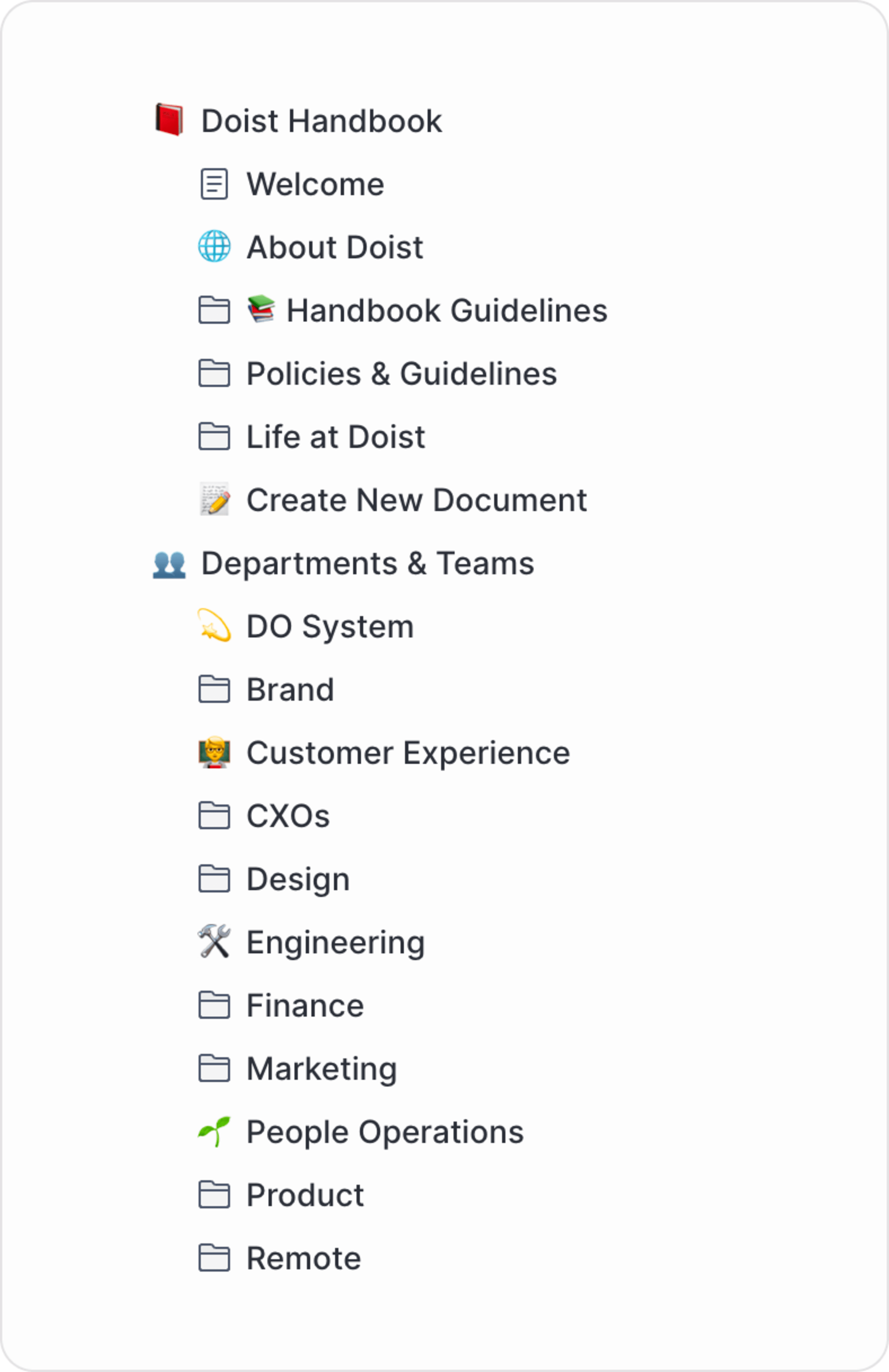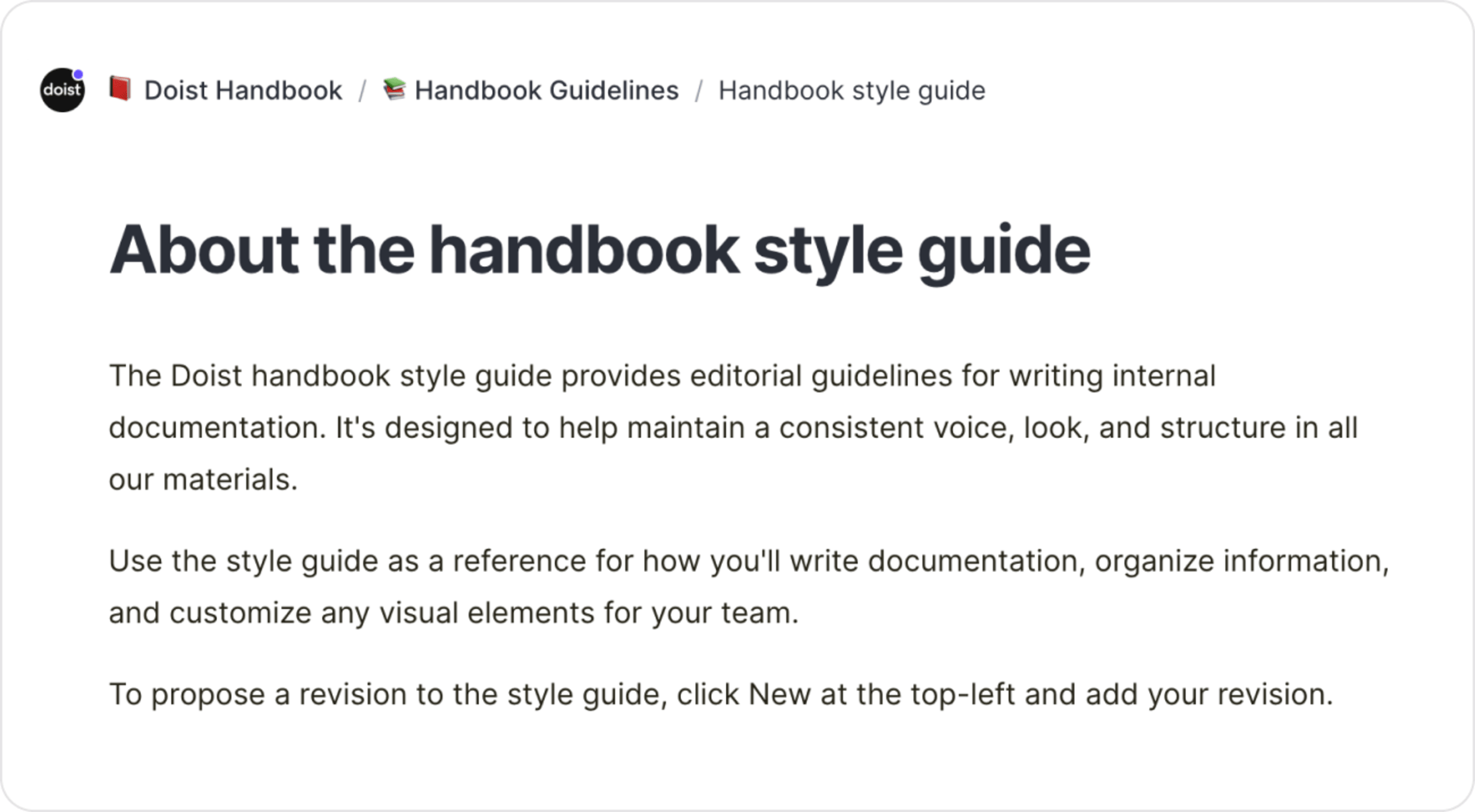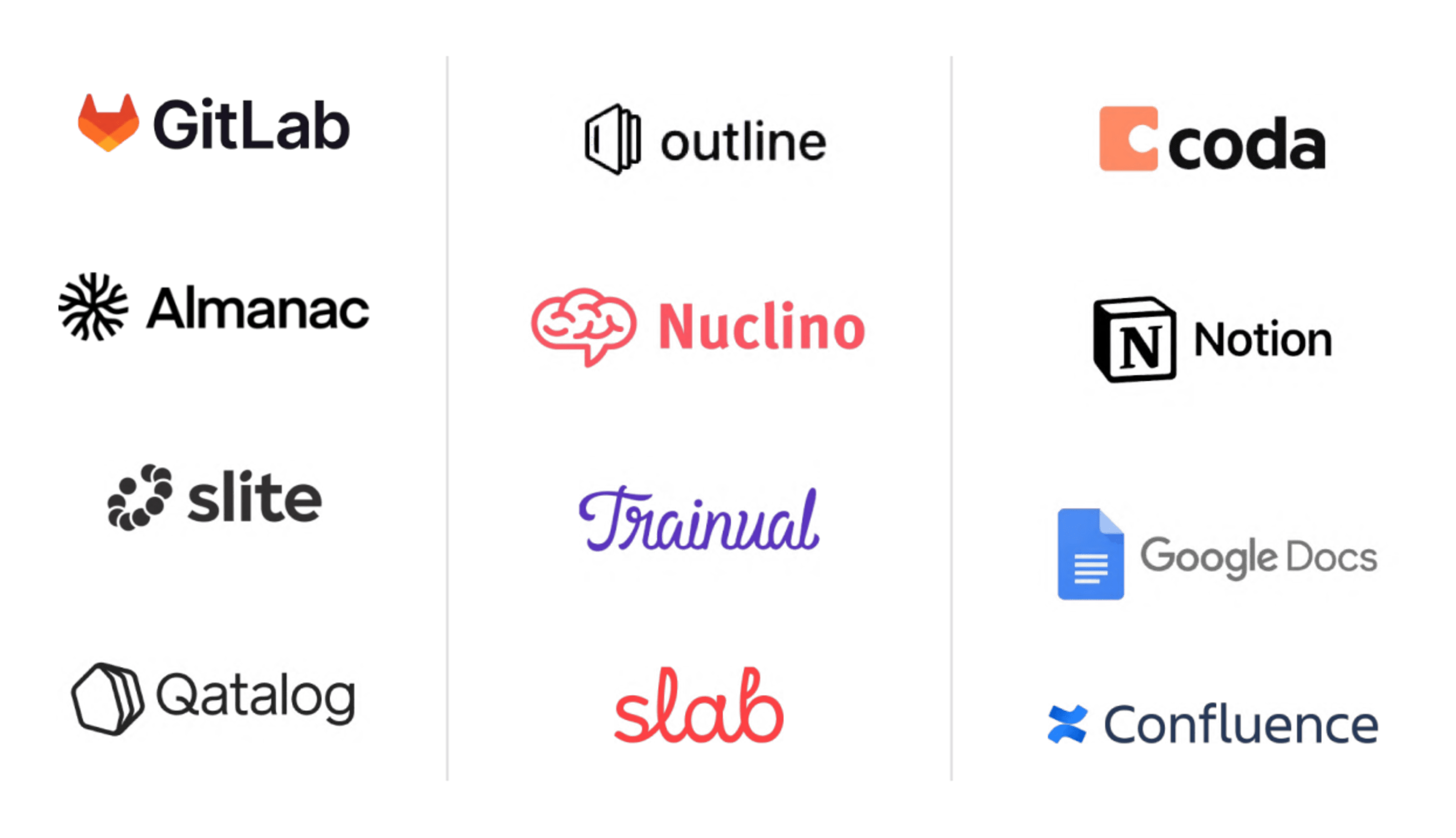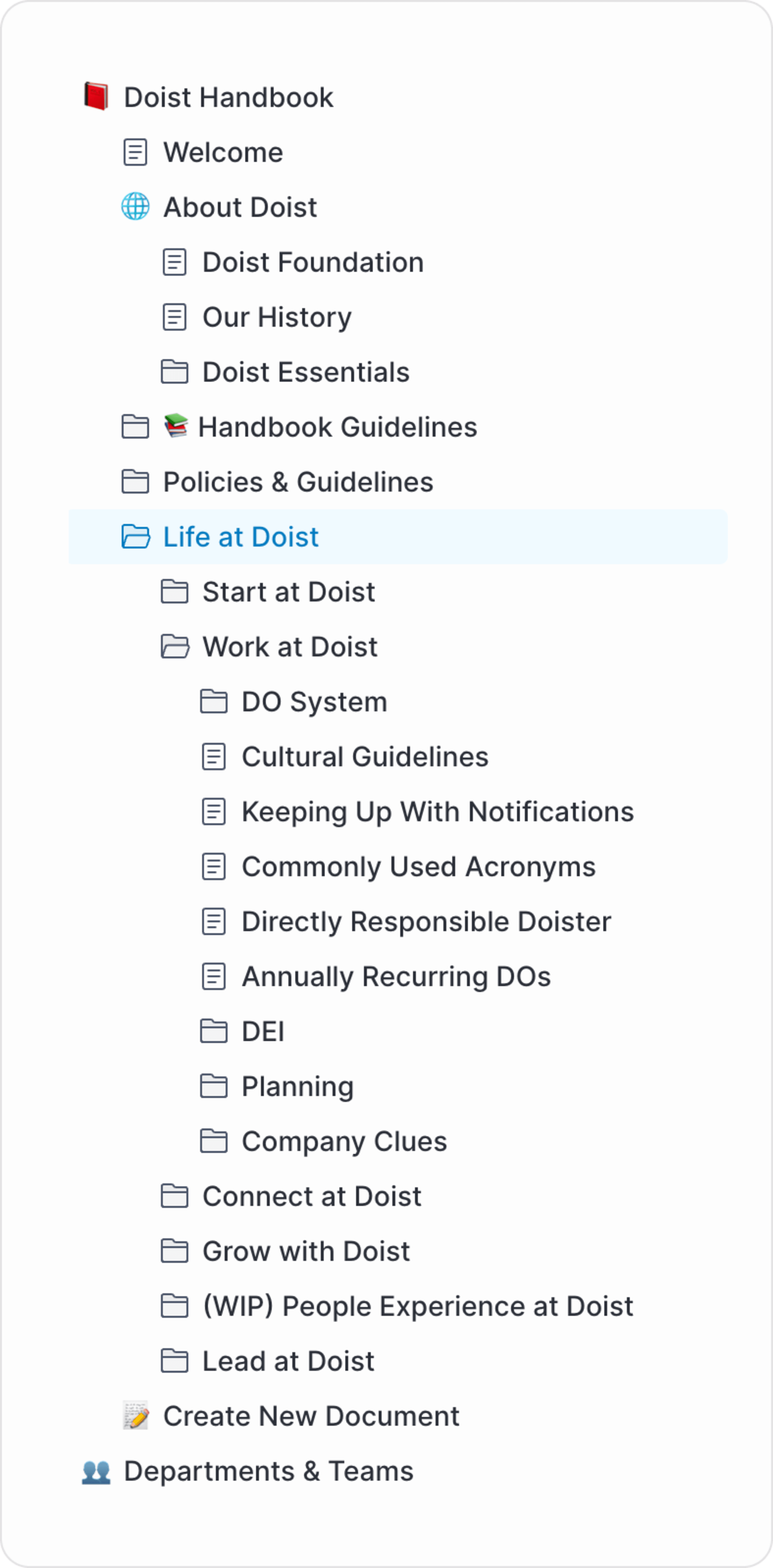In the modern era of work, the need for seamless access to information and knowledge sharing has grown exponentially.
That’s why providing a centralized hub for knowledge, processes, and workflows via a well-structured company documentation system has emerged as a linchpin for success in today’s working environment.
This article will share Doist’s journey with documentation as a team of nearly 100 people spread across all time zones. We’ll dive into the challenges, pitfalls, and principles we have used to build a robust team documentation system that organizations can leverage to enhance productivity, streamline operations, and foster a culture of trust and collaboration.
The Contents of Your Company Handbook
A company handbook is often also referred to as a documentation system or a central source of truth (SSoT). For the purposes of this article (and in the interest of simplicity), we’ll refer to it as a company handbook.
Some common items and topics found in a company handbook can include:
- Company Overview. An introduction to the organization, its mission, values, and culture.
- Team Roles and Responsibilities. Detailed descriptions of team roles, responsibilities, and reporting structures.
- Onboarding Procedures. A guide for new team members, including setup instructions, equipment, and access to essential tools.
- Communication Guidelines. Guidelines for communication, including preferred channels, response times, and etiquette.
- Work Hours and Time Zones. Information about team members' work hours, time zone differences, and scheduling considerations.
- Work Policies and Practices. Policies related to both office work and remote work, such as expectations, flexibility, performance evaluation, and best practices for staying productive, maintaining work-life balance, and managing remote work challenges.
- Technology and Tools. Descriptions of the software, tools, and platforms used for communication, collaboration, and project management.
- Security and Data Privacy. Guidelines for maintaining security and data privacy while working remotely.
- Meetings and Collaboration. Best practices for meetings (both virtual and in-person), collaboration, and project management.
- Documentation Standards. Guidelines for creating, organizing, and maintaining documentation, including templates and naming conventions.
- Performance Reviews. Information on performance evaluation processes and criteria.
- Professional Development. Resources for skill development, training opportunities, and career advancement.
- Health and Well-Being. Resources related to physical and mental well-being, including remote work ergonomics and mental health support.
- Emergency Procedures. Guidelines for handling emergencies and contingencies, such as technical issues or crisis situations.
- Frequently Asked Questions. A section addressing common queries and concerns team members may have.
- Contact Information. A directory of team members, including their roles, contact details, time zones, and next of kin.
- Legal and Compliance. Information about legal and compliance requirements, including tax, employment, and data protection regulations.
- Cultural Norms. Insights into the team's culture, values, and social activities, including all team-building events.
- Updates and Revisions. Information on how the handbook is updated and where to find the most current version.
- Personal Operating Manuals. A document that outlines individuals’ work style, communication preferences, strengths, weaknesses, and other relevant information to help colleagues or team members understand how to collaborate effectively with you.
Of course, the content and structure of a company handbook may vary based on the organization's specific needs, industry, and size, but you can use this as a starting point and build what works best for you and your team.
“An effective digital handbook should serve as the virtual information desk of your organization -- a single destination where any person (employee, customer, partner or visitor) feels welcomed by your company and can have any question about it answered. If the handbook doesn't contain the answer directly, then it should guide you to it."
Laurel Farrer, Founder at Distribute Consulting
The Doist Documentation Journey
At Doist, we've been proudly remote-first since our Founder and CEO, Amir, started building Todoist in 2007, prioritizing the flexibility and efficiency that remote work offers.
Alongside this philosophy lives a dedication to transparent communication and documentation, which officially dates back over a decade ago when we codified our core value of Communication as the first official entry into what is now our company handbook.
Initially hosted on GitHub, today, our handbook lives in Almanac and houses 1200+ pages of invaluable content that powers our globally distributed team working almost entirely asynchronously.
We believe that these remote work practices can serve as inspiration for every company, so whether your team is distributed or not, we all benefit from better documentation and processes.
Challenges → Revamp
However, as I recently shared in a documentation workshop with the Running Remote Community, in 2022, the results of our bi-annual employee engagement survey surfaced some frustrations with our company handbook, and we quickly realized we were facing several challenges. After reviewing all the feedback, I summarized those challenges as:
- Content creation and editing were cumbersome in a tool built for housing code, not prose.
- Outdated documentation lingered and became stale.
- Staying on top of edits and new additions was difficult.
- Consistency was lacking in terms of appearance and usage (likely due to #5).
- There was a sense of collective responsibility but no clear ownership of the handbook.
This feedback fuelled a determination to create a top-notch company handbook that lived up to our standards to do everything at a world-class level. This year, we embarked on a three-month-long journey to revamp the handbook by rallying a cross-functional team (internally called a “squad”) to address these issues head-on.
That process revealed that we had a lot of room for improvement, which provided the opportunity to up-level our entire process and the structure of our company handbook.
Defining the Handbook's Objectives & Framework
Objectives
As we began to rebuild, we were initially tempted to jump straight into finding the perfect platform. However, we quickly realized the importance of first clarifying our objectives. To guide us in this process, we posed a series of crucial questions to the squad:
- Ownership and Responsibility: Who will be the directly responsible individual (internally a DRD, Directly Responsible Doister) for our handbook? Should it be everyone collectively, as it has been, or should we assign a single person or set of people to oversee it?
After careful consideration, we opted for a hybrid approach. We designated a single DRD for the entire handbook, allowing us to maintain agency and ownership over its quality and consistency. Additionally, we appointed DRDs for each team’s specific section of the handbook, empowering each team with the freedom to exercise control over their respective areas. - Permissions: What permissions should everyone have - read-only, edit, full access? What are the pros and cons of each?
To strike a balance between control and collaboration, we granted full edit access to the DRDs while providing the rest of the team with comment and suggestion access. This approach introduced more friction compared to our previous setup, but it significantly enhanced the quality of our documentation. - Consistency and Quality: What steps can we take, and what product features do we require to maintain consistency and high quality?
We decided to prioritize finding a platform that would help us elevate older documents and highlight new and recently updated ones. By assigning individual DRDs to each section, we also gained better control over maintaining consistency within those sections. - Structure and Organization: How should we structure the table of contents to serve the outlined expectations?
To achieve both centralized oversight and team-specific control, we restructured our handbook completely - giving intentional thought to how we would design our table of contents.
We now have a company handbook complemented by team sections with their sub-folders, each under the authority of its respective team DRD.
Additionally, we introduced comprehensive style guidelines to ensure that our DRDs maintain a consistently high standard of content.

Taking a methodical approach, which began with defining objectives and actively gaining insights from the team throughout the process, led to a much richer understanding of where we needed to take the company handbook.
Guidelines
Consistency in team documentation relies on clear standards and guidelines. These define how information should be documented and presented.
A few points to remember:
- Start with a style guide covering tone, language, headings, and visuals.
- Create templates for various document types like meeting notes, project plans, and knowledge base articles to maintain a consistent look.
- Emphasize clarity, brevity, and accessibility, encouraging straightforward communication.
- Prioritize logical structure and accessibility for all team members.
- Regularly review and update these standards with team input to ensure your documentation remains organized and valuable as your team evolves.
- Finally, encourage feedback from team members to refine and improve the documentation process continually.

A well-maintained set of standards and guidelines ensures that every piece of documentation contributes to a cohesive, organized, and valuable knowledge repository.
Choosing a documentation platform
Selecting the appropriate documentation platform is a pivotal decision.
In making this choice, consider the specific needs of your team. Are you seeking a user-friendly, cloud-based solution that enables seamless collaboration? Or do you require a robust platform with advanced version control features for highly technical documentation? Assess your team's preferences and technical requirements to identify the tool that best aligns with your goals.
Several popular options are available, each with its strengths. Tools like Confluence, Slite, Trainual, Notion, and Google Docs offer user-friendly interfaces and collaboration capabilities. While version control systems like GitHub and GitLab are preferred for technical documentation and coding projects. It's also essential to assess scalability, integration capabilities, and pricing when making your decision.
During our revamp, we reviewed nearly every platform we could find and so can recommend any of the below based on your needs:

Ultimately, we landed on Almanac as our platform of choice, due to a few key features:
- Offers version control, structured approvals, and revision history (more on these below)
- Meets minimum security standards (more below)
- Powerful search
- Ability to view and filter older documents and newly added or edited documents
- Rich text editing, commenting, and suggesting experience
- Supports multiple content formats and embeds, including text, images, videos, and attachments.
- Ease of import (and export, if ever needed) and assistance with the migration
- Excellent customer support
Ultimately, the platform should be intuitive, accessible to all team members, and adaptable to your evolving needs.
“Distributed teams are only as efficient and nimble as the tools available to them. At Atlassian, every single team uses Confluence as a source of truth. Precise, concise written documents enable team members to efficiently distribute information and make decisions. These documents often replace unproductive, verbally facilitated meetings and confusing email threads. They also enable self-service, meaning that if a team member needs access to important information before their colleagues have logged on for the day, they can find it themselves. This leads to fewer bottlenecks and single points of failure.”
Annie Dean, Head of Team Anywhere, Atlassian
More on Version Control and Revision History
Since the handbook is your team’s central source of truth, version control and revision history are extremely important to ensure this valuable information is always retrievable and well-controlled. Though this verbiage may change from product to product, generally speaking:
- Version control tracks each change or document update, allowing team members to access previous versions if needed. This feature is especially vital when multiple contributors are involved or when errors occur.
- Revision history provides a transparent record of who made specific changes and when, holding team members accountable for their contributions. It also aids in troubleshooting and identifying the source of discrepancies or issues.
By implementing robust version control and revision history practices, you can maintain the integrity of your documentation, safeguard against errors, and foster a culture of attention to detail, which will also help ensure that the documentation remains a trusted asset for the team.
More on Security and Accessibility
It may seem to go without saying, but in the world of documentation - over-communication is necessary - as is ensuring security and accessibility meet your standards.
Security needs will vary from team to team. Still, at a minimum, you’ll want to evaluate who has access to your documentation and, via which means to ensure that sensitive information remains protected from unauthorized access or breaches. Furthermore, access control mechanisms should be in place to restrict document access based on roles and responsibilities.
I recommend engaging with an expert on this topic (I’m not one - but luckily, Alex, our Head of Infrastructure is.
“Firstly, the company handbook should be accessible to everyone in the company, so we integrated it with Doist’s single sign-on system. This makes both onboarding and offboarding easier and more secure.
In terms of access control and authorization, there's no one-size-fits-all, but we opted for a democratic setup where published content is searchable by everyone. However, teams can have internal docs (e.g., drafts) they can hold to themselves before they're in a state to be shared more widely. We can also share parts of our handbook publicly as a way to inspire others on our mission to change the future of work.
From an authorization perspective, everyone can recommend suggestions and documentation owners review before approving the content. This helps us maintain the quality of content and organization while promoting collaboration – the handbook is made by all and for all.
Authentication and authorization make up the first 2 of 3 As that describe the security traits expected in a professional tool. The third one is auditing: all changes made and all reviews are recorded. This makes it easy to spot honest mistakes and fix them or simply engage with the right people to update content.”
Alex Rodrigues - Head of Infrastructure at Doist
After choosing your platform
Organize Information Effectively
A well-structured company handbook ensures that information is not only accessible but also easily navigable. Start by creating a logical hierarchy and categorization system for your documentation. This involves arranging documents in a clear and intuitive manner, which creates a roadmap for team members to navigate all the information.
Here are a few tips to keep in mind:
- Encourage teammates to use the robust search capabilities to help them find the information they need.
- Implement a standardized naming convention for documents to ensure consistency and clarity in file identification.
- Link and cross-reference documents wherever possible to allow for seamless navigation between related topics.
- Periodically review and optimize your documentation structure to ensure that it continues to meet the evolving needs of your team.
- Solicit feedback from team members to identify pain points or areas for improvement in information organization.

Document the Workflows and Processes
One of the pillars of a highly effective company handbook is properly documenting how to use the handbook itself. As simple as that seems, this small step often goes overlooked.
Documented processes reduce the time spent on decision-making and troubleshooting, enabling team members to focus on execution. These documents also encourage team members to regularly review and update workflows and processes so teams can identify bottlenecks and areas in need of optimization.
Here are a few key guidelines to offer:
- How to create new documents
- How to edit current documents
- Links to style guides and formatting expectations
- Expected use of power features in the platform
- Expectations for regular reviews and updates
- Directly Responsible Individuals and their respective tasks and cadences
Training, Onboarding, Review, and Maintenance
On the surface, a handbook seems fairly straightforward, but don't overlook training and onboarding. Properly preparing team members with clear guidance on your documentation system ensures effective utilization, and preparing materials today will set your team up for success as new employees join the company.
Once we decided on our platform and the above details, we laid out an onboarding plan that included:
- Clear documentation and how-to-guides to be read asynchronously
- Beta testing before rolling the new solution out to the team
- Multiple synchronous training sessions
- A dedicated channel in Twist to provide detailed critical feedback
Once the solution was in place, we started a recurring review and maintenance process that ensures we’ll avoid having outdated or inaccurate documentation. As the DRD of the handbook, I have daily and weekly recurring tasks in my Todoist to help me stay on top of this.
Promote a Documentation Culture
Building a documentation culture within your organization is not a one-time effort; it's an ongoing commitment. Here are a few suggestions to help instill this culture effectively:
- Lead by example. As a leader or manager, actively engage in documentation efforts and showcase the value it brings to the team. When team members see leadership's commitment, they are more likely to embrace and prioritize documentation themselves.
- Establish clear objectives and communicate the importance of documentation to all team members. Regularly highlight how it contributes to efficiency, problem-solving, onboarding, and overall team success, and provide training and resources to ensure team members have the tools and knowledge to document effectively.
- Celebrate those teammates who are actively participating in curating this culture. That recognition will entice others to contribute and encourage high-quality effort.
- Integrate documentation into your team's daily processes. Encourage team members to document their work as they go, rather than viewing it as a separate task. Emphasize collaborative documentation, where multiple team members can contribute to and review documents, ensuring accuracy and comprehensiveness.
- Regularly review and update documents to keep them accurate and relevant. Encourage a feedback loop, where team members provide input and suggestions for improving documentation practices.
By actively promoting and nurturing a documentation culture, your organization can harness the full potential of this invaluable resource.
Conclusion
"Structure, clarity, and meaning are three proven principles of effective teams. A rigor around documentation bolsters all of these pillars, ensuring that teams operate from a single source of truth. Systematically writing things down creates leverage for productivity and, critically, purges ambiguity from an organization's culture."
Darren Murph, Strategy and Operations at Ford, former Head of Remote at GitLab
The ability to document processes, share knowledge, and maintain clear communication is indispensable.
By establishing clear objectives, choosing the right tools, fostering a culture of documentation, and adhering to best practices, teams can unlock the true potential of their collaborative efforts.
Embrace these principles, and your company will thrive in an era where seamless communication and information sharing are the keys to productivity and innovation.
Building a Company Handbook Todoist Template
This article is packed full of actionable advice, but we know there is a lot of it. So we've created a Todoist template for Building a Company Handbook with all of this advice distilled into a checklist. Now you can get started on turning this knowledge into action (and your own company handbook.)

